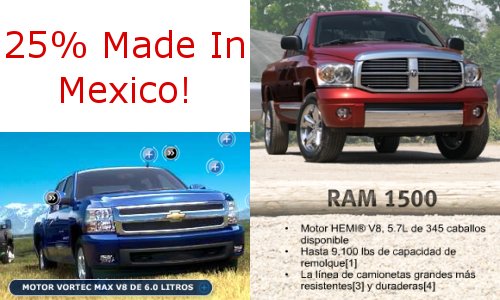 All Entries in the "Auto News" Category
All Entries in the "Auto News" Category
Auto News From Around The Web August 25 2008
First up, Edmunds.com posted a 2009 Dodge Ram first drive report on their Inside Line blog last week. While Edmunds was quick to point out that the vehicle they drove was a prototype, their review of the new Ram’s rear coil suspension was very complimentary. Here’s a snippet:
A set of gargantuan coil springs now supports the back half of the new Ram, improving ride and stability while miraculously preserving the payload and towing capacity of the 2008 model. If the competition doesn’t already have prototypes and test mules running around with this setup at their respective proving grounds, they’d best get on the ball.
Edmunds also went on to say that the new HEMI will have variable-valve timing (Tundra already has VVT-i), variable length intake runners (Tundra already has a similar acoustically controlled induction system), and a higher compression ratio than the old engine. Combined with Dodge’s cylinder de-activation system, the claim is that the new Ram will have slightly better fuel economy (13/19) while adding 45 hp for a total of 390 hp.
Sounds pretty awesome – we can’t wait to drive one. The coil spring suspension sounds good too, but it is interesting to note that Dodge didn’t increase the payload or tow rating of the 2009 Ram, despite increasing the power of the 5.7 Hemi substantially. Does this mean Dodge couldn’t make the new rear coil suspension any stronger than the old leaf setup? If so, that doesn’t speak well of it’s towing and hauling ability (especially long term). Again, it’s a prototype, so who knows…
GM and Ford Playing A Little TOO Nicely
 General Motors and Ford Motor Company may be on the road to collaboration on new engine and powertrain development, according to a report by the Detroit News. With gas prices reaching unprecedented heights and pick-up and SUV sales hitting new lows, the collaboration could be the one bright spot in both companies
General Motors and Ford Motor Company may be on the road to collaboration on new engine and powertrain development, according to a report by the Detroit News. With gas prices reaching unprecedented heights and pick-up and SUV sales hitting new lows, the collaboration could be the one bright spot in both companies
Tundra Tops 2008 J.D. Power Long Term Dependability Results
J.D. Power and Associates recently published their 2008 long term vehicle dependability study, and the Toyota Tundra was rated as the most dependable truck in it’s segment.
Long-term dependability is based on the “reported problems” per vehicle over the course of 3 years. So, the 2008 study is based on 2005 models, the 2009 study will be based on 2006 models, etc. It’s information about a vehicle that was made three years ago. While it’s nice to talk (cough-brag) about the award, we’re not sure that this study by itself is particularly meaningful.
Toyota Tundra More American Than Silverado AND Ram
Twice a year, Cars.com creates a list of the “Ten Most American Cars.” Last year, we talked about how the Tundra was more American than the Dodge Ram. This year, we can talk about the fact that the Tundra is more American than both the Dodge Ram AND the Chevy Silverado.

The Ram and Silverado are more than 25% percent made in Mexico, making them less American than the Toyota Tundra according to Cars.com.
Cars.com calculates which vehicles are “most American” based on production location, percentage of domestic parts content, and American sales volume for each vehicle.
Toyota Consolidates Tundra Manufacturing, HD Tundra Tabled?
In a very wise move, Toyota has announced that they’re going to consolidate all Tundra production to the San Antonio plant. Currently, Tundras are produced in both San Antonio, Texas and Princeton, Indiana. Originally, before the launch of the 2nd-generation Tundra, Toyota decided to produce the Tundra at a couple of different plants for a few reasons:
- Facilities and convenience. The Princeton plant was the home of the original first-gen Tundra, and a lot of suppliers for the 2nd-gen truck were nearby and accustomed to working with the Princeton, Indiana plant.
- Quality at launch. Toyota wisely determined that launching an all-new truck at an all-new plant might be a quality control issue, so they decided to use the tried-and-true Princeton plant to produce the new truck along with the new San Antonio plant. This reduced the number of variables when it came to quality control and helped Toyota isolate production problems correctly.
- Capacity. This is the main reason – Toyota anticipated they would need all the production capacity they could get for the new Tundra half-ton and upcoming Tundra HD. At full speed, the Princeton plant could build 150k new trucks per year. The San Antonio plant has the capacity to build 250,000 units per year. Obviously, Toyota anticipated producing as many as 400k units between the two plants. Considering the future plans that were being discussed at the time – a diesel HD version of the Tundra as early as 2009, for example – it was determined this capacity was needed.
What this means to you: If you’re waiting for an HD Tundra, you might be waiting a while. The costs of producing a diesel HD Tundra are substantial. Not only are there quite a few R&D costs (such as designing a new big diesel, platform design, etc.), but now there are production concerns too. Since the San Antonio plant has a maximum annual production capacity of 250k units, there’s not a lot of extra capacity to build an HD version of the Tundra.
Here’s why:

